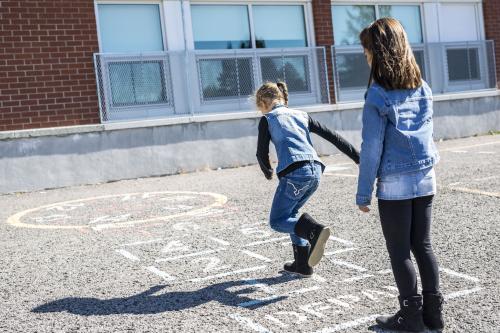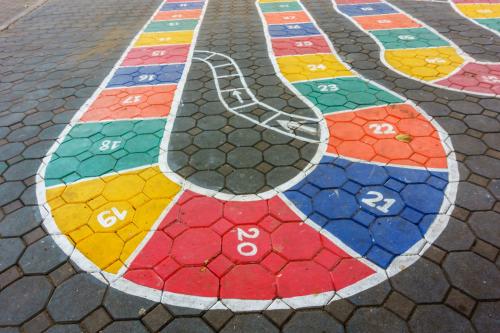Recent reports from the Center for Disease Control (CDC), the Society of Health and Physical Educators (SHAPE America), and the National Physical Activity Plan highlight the importance of play in schools and the urgent need for shared definitions and assessment resources. The full spectrum of play can be measured by assessing safe and healthy play, which is why Playworks is developing the Great Recess Framework.
While researchers, educators, and parents agree that play has tremendous benefits for kids, there is debate around the level of adult supervision and structure needed to facilitate the optimal outcomes for youth. Measuring the number of minutes that kids engage in active play can encourage adult-led, highly structured activities to achieve active minutes, which do not achieve the full benefits of play. According to Stuart Brown of the National Institute for Play, play is “voluntary, it’s pleasurable, it offers a sense of engagement, it takes you out of time.” We believe it is this voluntary characteristic of play that taps children’s intrinsic motivation to get in the game, and being voluntarily in the game ensures a wide range of benefits for all kids.
The full spectrum of play, from make believe to soccer, can contribute to healthy child development. Play helps students develop socially, emotionally, physically, and academically. During play, students learn and practice important skills, such as cooperation, conflict resolution, respect for others, and self-regulation. Some adult support is needed to facilitate safe and healthy opportunities for all kids to play, and then the adults can step back and allow the play to unfold.
There is currently a lack of tools to assess the quality of recess and physical activity in elementary schools. In January, the CDC and SHAPE America released Strategies for Recess in Schools, but they have not yet shared assessment guidelines. In November, the National Physical Activity Plan released the 2016 U.S. Report Card on Physical Activity for Children and Youth, but as in the last report, the authors were not able to assess or assign a grade for the “Active Play” indicator. The panel developing the report aimed to measure active play, and no valid assessment for that definition of play currently exists. As an alternative, we recommend the panel evaluate whether or not kids have access to environments which provide the opportunity for safe and healthy play.
There is currently not a validated assessment tool because there is a lack of insight into the indicators that ensure specific outcomes are achieved through play. The sector needs to focus on indicators for which schools are accountable. To address this need, Playworks is creating the Great Recess Framework, a tool that can be used to assess safe and healthy play in schools.
In creating the Great Recess Framework, Playworks is drawing on our experience to present an assessment tool aligned with the CDC and SHAPE America’s new guidelines. It focuses on a variety of indicators that any school can use to assess if they have a recess environment in which all students are safe, engaged, and empowered to play every day. An external researcher from Concordia University has taken initial steps to test the reliability of this tool, designed to become the standard by which to judge our national success at ensuring play in schools.
In this kind of environment, active play is more likely. For example, one indicator asks whether “[a]lmost all games are inclusive to a variety of groups by gender, ability, race and/or age.” The Shape of the Nation: Status of Physical Education in the USA notes that during games, students are even more likely to be physically active than in physical education class. Inclusion in games, in addition to being important in its own right, predicts more physically active play. A randomized control trial of Playworks schools by Stanford University and Mathematica Policy Research found that girls, African-American students, and Hispanic students were more active on playgrounds with a culture of inclusivity.
Other indicators ask whether “[t]here were no disagreements about rules between students,” and whether “[t]he play space for recess is appropriate in that there are no immediate safety concerns.” A safe environment is the first building block for healthy play—especially for active play. Chaotic recess environments are unsustainable; when injuries and conflicts are rampant, many schools ban active games like tag entirely. Setting reasonable ground rules for safety, like teaching students to tag with light, “butterfly fingers” or making dangerous areas of the playground off limits, can allow active play to flourish.
It is critical that we analyze play under a shared definition and assessment tool, so there is a collective understanding of what impact quality play can have for all children in all schools.
If all students have access to safe and healthy play every day, then we can empower a generation of kind people to lead us into the future.






Commentary
A new way to measure the benefits of school recess
February 13, 2017